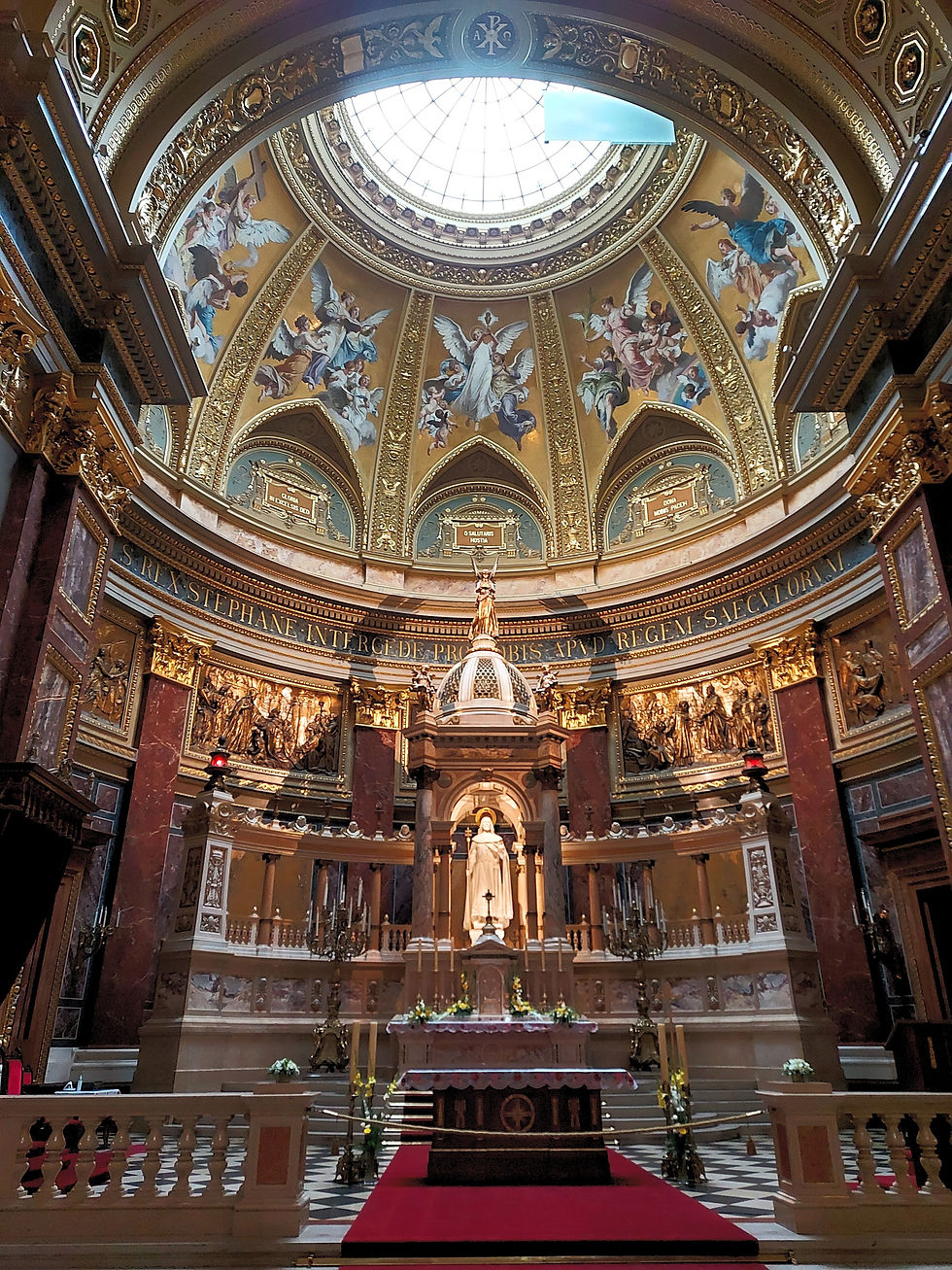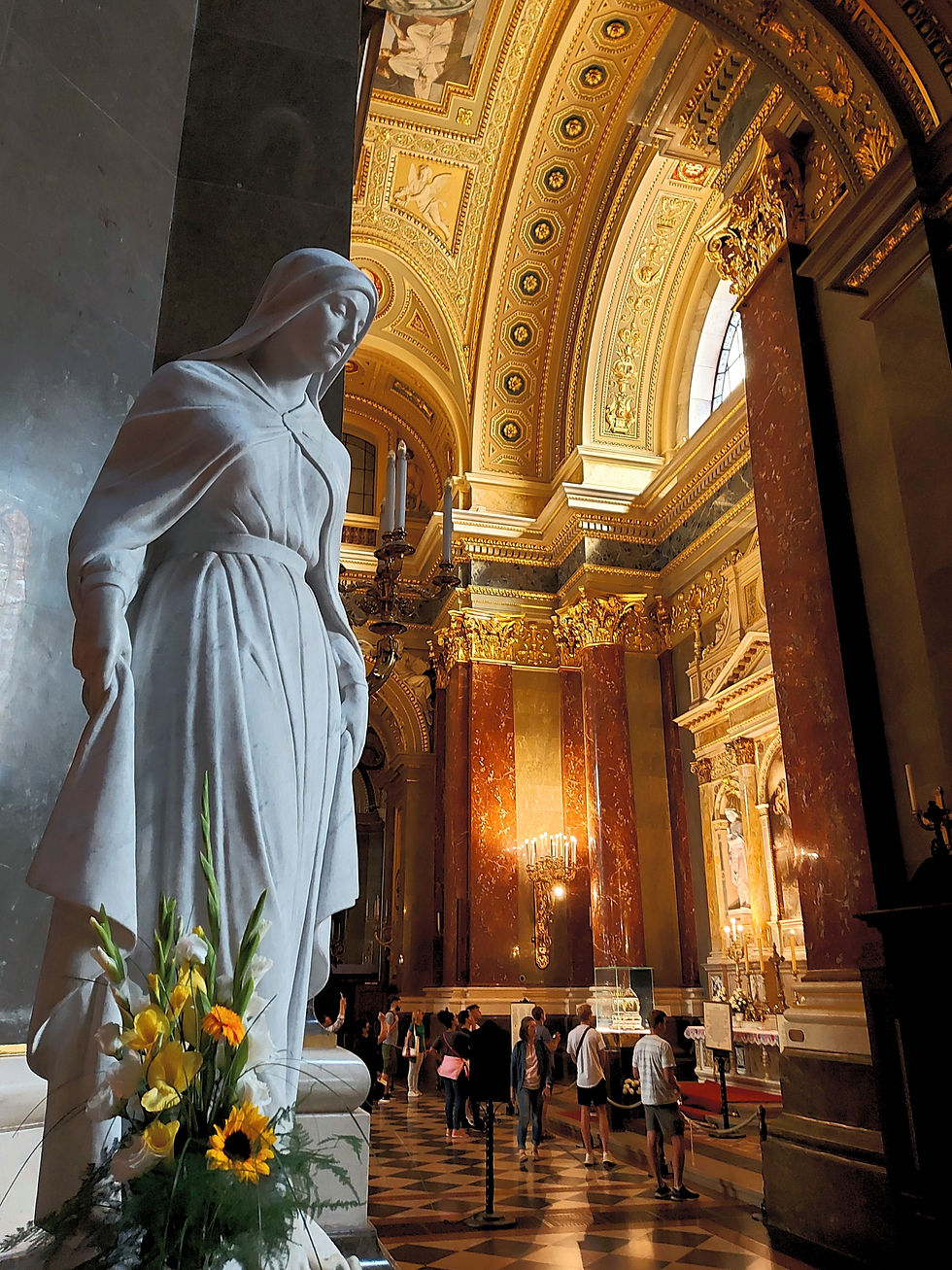Visiting The Saint Stephen's Basilica
- Gems of Budapest

- Jun 2, 2025
- 4 min read
Updated: Aug 5, 2025

Saint Stephen's Basilica in Budapest © www.gemsofbudapest.com 2025
Saint Stephen's Basilica in Budapest
The Saint Stephen's Basilica (in Hungarian: Szent István Bazilika), located in downtown Budapest, Hungary, stands as a testament to the city's rich history and architectural grandeur. Named after Hungary's first king, Saint Stephen, the basilica's construction began in 1851 under the direction of architect József Hild, though it faced several delays due to Hild's death and subsequent changes in design and leadership.

Where to find it?
H-1051 Budapest, Szent István tér 1.
For further information, please visit the homepage of the Basilica:
Please note that during wedding ceremonies over the weekends, the visit in the church hall could be restricted.
Upon Hild's passing in 1867, architect Miklós Ybl took over the project, implementing significant alterations to the original plans. Ybl's vision aimed for a grander, more elaborate structure, incorporating elements of neoclassical and neo-renaissance styles.
On January 22, 1868, at 5.10 p.m. the cupola and the cupola drum constructed according to the designs of Hild collapsed due to defects in materials and craftmanship. Ybl recognized the defect and averted hazard to life, however, he could not prevent the disaster, after which he designed a new neo-renaissance building on reinforced foundations.

Saint Stephen's Basilica in Budapest in 1900, source: Fortepan, from the photos of György Klösz
Construction was finally completed in 1905, after the interior decoration, supervised by József Kauser, was ready.
Since then, the basilica's dome, reaching a height of 96 meters (315 feet), became an iconic symbol of Budapest's skyline.

Saint Stephen's Basilica in Budapest © www.gemsofbudapest.com 2025
Within the Saint Stephen's Basilica, the prominence of its namesake, Saint Stephen, is evident in various aspects of its design and decoration. One notable feature is the altar dedicated to Saint Stephen, which serves as a focal point for religious ceremonies and reverence.

The main altar in Saint Stephen's Basilica in Budapest © www.gemsofbudapest.com 2025
The altar features depictions or symbols associated with Saint Stephen's life and legacy. As the first king of Hungary and a pivotal figure in the country's Christianization, Saint Stephen holds a revered status in Hungarian history and religious tradition. Depictions of him often include imagery of his coronation, his efforts to spread Christianity in Hungary, and his role in establishing the Hungarian state.
Additionally, Saint Stephen's relics may be housed within the basilica, further emphasizing his significance as a saint and national patron. Relics are physical remains or objects associated with a saint, believed to possess spiritual significance and the power to intercede on behalf of believers. Saint Stephen's relics, particularly his sacred right hand, are revered as objects of veneration and symbols of divine intervention.

Saint Stephen's sacred right hand housed in the Saint Stephen's Basilica © www.gemsofbudapest.com 2025
According to legend, Saint Stephen's right hand miraculously survived decomposition after his death in 1038, remaining intact and uncorrupted. This preservation was interpreted as a sign of Saint Stephen's sanctity and divine favor. The hand, believed to possess miraculous powers and the ability to perform healing miracles, became a treasured relic for the Hungarian people.

The interior decoration of the main dome of the Saint Stephen's Basilica © www.gemsofbudapest.com 2025
Throughout history, Saint Stephen's right hand has been safeguarded and enshrined in various locations, including the Basilica of Saint Stephen in Budapest. Pilgrims and devout believers journey from near and far to pay homage to the relic, seeking spiritual solace and divine intervention in their lives.
Breathtaking Views of Budapest from the Panoramic Terrace of Saint Stephen's Basilica
The panoramic terrace of Saint Stephen's Basilica offers visitors a breathtaking view of Budapest's picturesque skyline, providing an unparalleled vantage point to admire the city's architectural splendor. Accessible via a climb of 364 steps, the terrace rewards those who ascend with sweeping vistas of the Danube River, the iconic Hungarian Parliament Building, and the historic landmarks that dot the landscape. From this elevated vantage point, visitors can appreciate the intricate details of the basilica's neoclassical façade and the majestic dome that crowns the structure.

The view from the top of the Saint Stephen's Basilica
Additionally, within the basilica lies a hidden treasure trove of religious artifacts and relics, including intricately crafted golden vessels, precious gemstones, and ornate religious vestments. These treasures, housed within the basilica's sacristy, serve as tangible reminders of Hungary's rich religious heritage and the enduring legacy of Saint Stephen, the nation's patron saint. Visitors to Saint Stephen's Basilica can marvel not only at its architectural magnificence but also at the priceless treasures that lie within its hallowed halls, offering a glimpse into Hungary's storied past and cultural heritage.
Regarding the basilica's status, it holds the title of "basilica minor." In Catholicism, a basilica is a large and important church granted special ceremonial rights by the Pope. The title of "minor basilica" distinguishes it from "major basilicas" in Rome, such as St. Peter's Basilica. Basilicas are typically recognized for their historical, architectural, or religious significance, and the title is conferred by papal decree.

The interior decoration of the Saint Stephen's Basilica in Budapest, © www.gemsofbudapest.com 2025
For the Saint Stephen's Basilica, being designated as a basilica minor reflects its importance within the Catholic Church and its role as a significant religious site in Hungary. This status may entail certain privileges, such as the ability to celebrate specific liturgical rites and ceremonies, as well as increased prestige within the Catholic community.

The portrait of Saint Stephen on the outside of the Basilica in Budapest © www.gemsofbudapest.com 2025
Overall, the inclusion of Saint Stephen on the basilica's altar and its designation as a basilica minor underscore its dual significance as both a place of worship and a cultural landmark, honoring Hungary's religious heritage and architectural splendor.
Throughout its history, the Saint Stephen's Basilica has witnessed numerous renovations and restorations, preserving its architectural splendor for future generations. Its interior showcases exquisite marble work, intricate frescoes, and ornate stained glass windows, contributing to its status as one of Hungary's most beloved religious and cultural landmarks.
Beyond its religious significance, the basilica also serves as a venue for concerts, offering visitors the opportunity to experience its majestic acoustics within a breathtaking setting.
Despite facing challenges and setbacks during its construction, the Saint Stephen's Basilica stands today as a symbol of resilience, perseverance, and the enduring spirit of Budapest. Its majestic presence continues to captivate locals and tourists alike, drawing admiration for its architectural beauty and historical significance.








